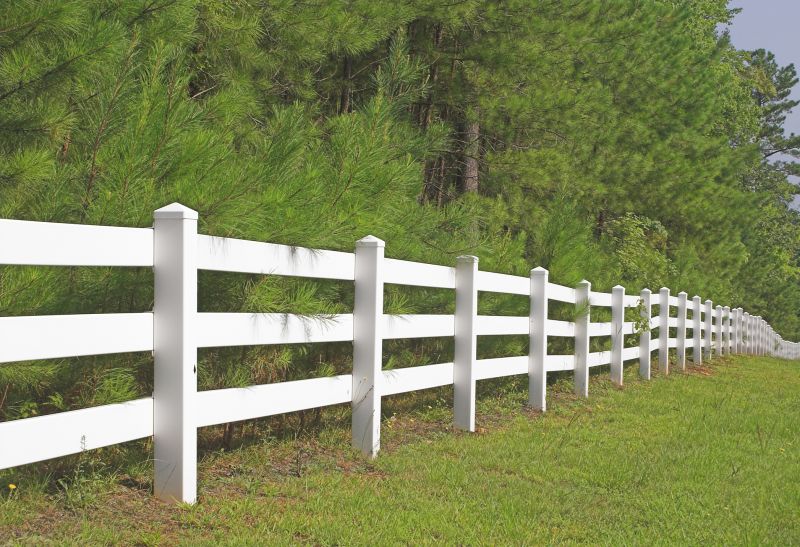Favorite Products For Building a Classic Split Rail Fence
Browse the most popular tools and materials that help you create a traditional split rail fence with ease and durability.
 Split rail fencing has long been a popular choice for delineating property boundaries, containing livestock, or enhancing landscape aesthetics. Its rustic charm and straightforward installation process make it a versatile option for many outdoor settings. When selecting products for split rail fence installations, it is important to consider the materials, durability, and compatibility with your specific project needs. From traditional wood options to alternative materials, there is a variety of products designed to facilitate a secure and visually appealing fence structure.
Split rail fencing has long been a popular choice for delineating property boundaries, containing livestock, or enhancing landscape aesthetics. Its rustic charm and straightforward installation process make it a versatile option for many outdoor settings. When selecting products for split rail fence installations, it is important to consider the materials, durability, and compatibility with your specific project needs. From traditional wood options to alternative materials, there is a variety of products designed to facilitate a secure and visually appealing fence structure.
Top Overall Option
Wood Post and Rail Fencing Kit
A comprehensive wood post and rail fencing kit provides a versatile foundation for creating a traditional split rail fence. These kits typically include pre-cut rails, sturdy posts, and necessary hardware, simplifying the installation process for DIY enthusiasts and professionals alike. Choosing high-quality, pressure-treated wood can help ensure durability and resistance to outdoor elements, making it suitable for various climates. The natural appearance of wood complements rustic landscapes and offers flexibility in customization, allowing for adjustments in height and spacing to suit specific needs.
Types of Products For Split Rail Fence Installations
Wood Posts
Wood posts serve as the primary vertical supports in split rail fencing, available in various sizes and treatments to enhance longevity.
Split Rail Rails
Pre-cut or custom-cut rails that fit between posts, typically made from wood, composite, or vinyl materials.
Metal Post Brackets
Hardware that secures rails to posts, providing extra stability and ease of assembly.
Post Caps
Decorative or protective caps that fit atop posts to prevent water infiltration and add aesthetic appeal.
Fence Stain and Sealant
Protective coatings that help preserve wood and enhance appearance over time.
Concrete Mix
Used to set posts securely into the ground, ensuring stability for the fence structure.
Fasteners and Nails
Hardware necessary for attaching rails to posts and securing components during installation.
Vinyl or Composite Rails
Alternative to wood, offering low-maintenance options with similar visual characteristics.
Adjustable Post Mounts
Hardware that allows for precise alignment and leveling of posts during installation.
Fence Gate Hardware
Components such as hinges and latches designed for split rail gates.
Decorative Elements
Optional features like finials or ornamental caps to enhance aesthetic appeal.
Rail Connectors
Specialized hardware that joins rails securely and maintains alignment.
Fence Post Extenders
Accessories that increase post height for added privacy or design variation.
Ground Anchors
Devices to provide additional stability in challenging soil conditions.
Popular Choices
Standard posts treated to resist rot and insects, suitable for most outdoor environments.
Ready-to-install rails that simplify the fencing process and ensure uniformity.
Corrosion-resistant hardware that enhances the strength of rail-to-post connections.
Caps that add a finishing touch while protecting the post tops from water damage.
Protective stain designed to preserve wood appearance and durability.
Set posts securely into the ground for added stability in various soil conditions.
Robust fasteners suitable for outdoor use and long-term durability.
Low-maintenance alternative rails that mimic traditional wood appearance.
Hardware that facilitates precise installation and alignment of fence posts.
Reliable hardware designed specifically for split rail gates.
Components designed to withstand outdoor conditions and maintain appearance.
Markers to help visualize property boundaries during installation.
Ties that help secure rails to posts in uneven terrain or challenging conditions.
Accessories to increase fence height or customize design.
Stabilizing devices for challenging or rocky soil conditions.
The installation process typically involves selecting the right type of posts and rails, which serve as the backbone of the fence. Properly treated wood or durable composite materials can withstand outdoor elements and prolong the lifespan of the fence. Accessories such as post caps, fasteners, and connectors also play a vital role in ensuring stability and ease of assembly. Additionally, considering the overall height and spacing of the rails can influence the fence's functionality and aesthetic appeal.
For those seeking a low-maintenance solution, synthetic or composite materials offer an attractive alternative to traditional wood, often requiring less upkeep while providing similar visual appeal. Meanwhile, metal brackets and hardware can enhance the structural integrity of the installation, especially in areas prone to high wind or heavy use. Ultimately, choosing the right combination of products depends on your project's scale, budget, and desired look, but understanding the available options can help you make informed decisions for a successful split rail fence installation.
Key Buying Considerations
- Material durability and resistance to weather elements
- Compatibility of post and rail sizes with your fencing layout
- Ease of installation and availability of installation hardware
- Desired aesthetic appearance and finishing options
- Maintenance requirements and long-term upkeep
- Budget constraints and cost-effectiveness of materials
- Soil and ground conditions affecting stability
- Environmental exposure, such as wind or heavy snow loads
- Compatibility with existing landscape features
- Availability of accessories like post caps, hinges, and latches
- Potential for customization in height, spacing, and design
- Local building codes or regulations affecting fencing choices
- Environmental factors that may influence material selection
- Options for low-maintenance or synthetic materials
- Potential for expansion or future modifications
